18650 vs 21700 Cells Which Battery Is Best for Flashlights and Power Banks
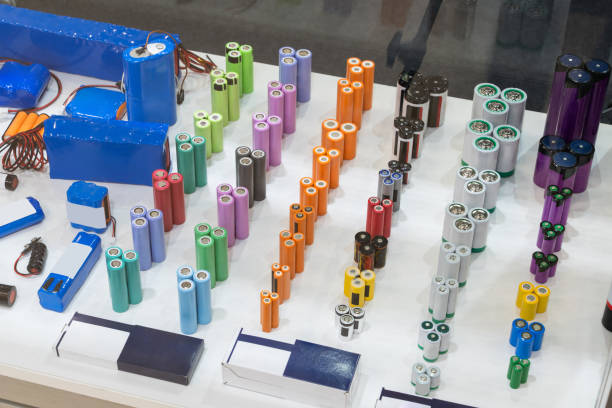
For most users, the 21700 battery offers the best performance in modern flashlights and power banks, thanks to its higher capacity and longer runtime. However, the right choice depends on device compatibility, how long you need your device to run, and your budget. Compact devices often favor the 18650 battery because of its smaller size and proven fit. The demand for battery cells continues to grow, especially as people rely on portable power more than ever.
Application | Market Share (2023) | Notes on Demand Trends |
|---|---|---|
Power Banks | ~40% | Largest share driven by mobile device usage and portable charging demand |
Flashlights & Others | ~5% | Smaller share but expected to grow due to compact battery design improvements |
Other Applications | ~10% | Includes medical devices and power tools |
When comparing 18650 lithium-ion cells vs 21700 rechargeable cel, users should weigh size, runtime, and price. The debate over 18650 and 21700 Cells: Ideal for flashlights comes down to matching the battery to your device and needs.
Key Takeaways
21700 batteries offer longer runtime and higher power, making them ideal for high-performance flashlights and power banks.
18650 batteries are smaller and more compact, fitting many older devices and often costing less upfront.
Always check your device’s battery size compatibility to avoid damage and ensure safe operation.
21700 batteries provide better energy density and last longer through more charge cycles, giving better long-term value.
Use trusted brands and proper chargers, and follow safety tips to extend battery life and maintain performance.
Key Differences Between 18650 and 21700 Batteries
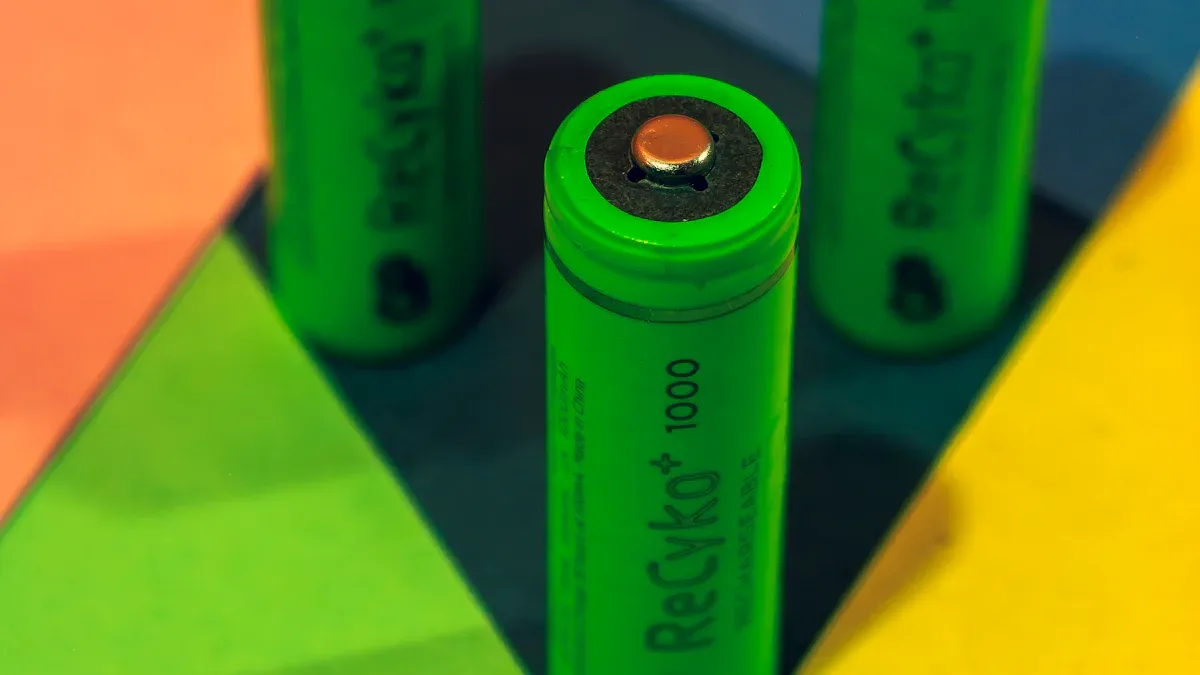
Specs Overview
The key differences between 18650 and 21700 batteries begin with their physical size and technical features. Both types belong to the lithium-ion family, but their dimensions and battery capacity set them apart. The 18650 battery measures 18 mm in diameter and 65 mm in length, while the 21700 battery is larger at 21 mm in diameter and 70 mm in length. This increase in size leads to a significant difference in capacity and performance.
Feature | 18650 Battery | 21700 Battery |
|---|---|---|
Diameter | 18 mm | 21 mm |
Length | 65 mm | 70 mm |
Volume | ~16,532 cubic mm | ~24,233 cubic mm (47% larger) |
Capacity (mAh) | 2000 - 3500 | 3000 - 5000 |
Energy Density (Wh/kg) | 200 - 250 | 250 - 300 |
Internal Resistance | Higher | Lower |
Discharge Rate | Higher (better for high rate) | Lower (due to thicker electrodes) |
Pack Complexity | Higher number of cells needed | Fewer cells needed, simpler BMS |
Cost per Wh (pack) | Higher | Lower (due to fewer cells) |
The table above highlights the key technical differences. The 21700 battery offers higher capacity and energy density, making it suitable for devices that need longer runtime and better performance. The 18650 battery remains popular for its compact size and compatibility with many existing devices.
Note: Both 18650 and 21700 lithium-ion batteries share a similar nominal voltage, usually around 3.6 to 3.7 volts. However, the difference in capacity and size leads to different applications and performance outcomes.
Energy Density
Energy density measures how much energy a battery can store for its weight. This factor plays a major role in the performance of lithium-ion batteries. The 21700 battery stands out with a higher energy density, often reaching up to 300 Wh/kg, while the 18650 battery typically ranges from 240 to 250 Wh/kg. This difference in capacity means the 21700 battery can deliver more power and longer runtimes without a large increase in weight.
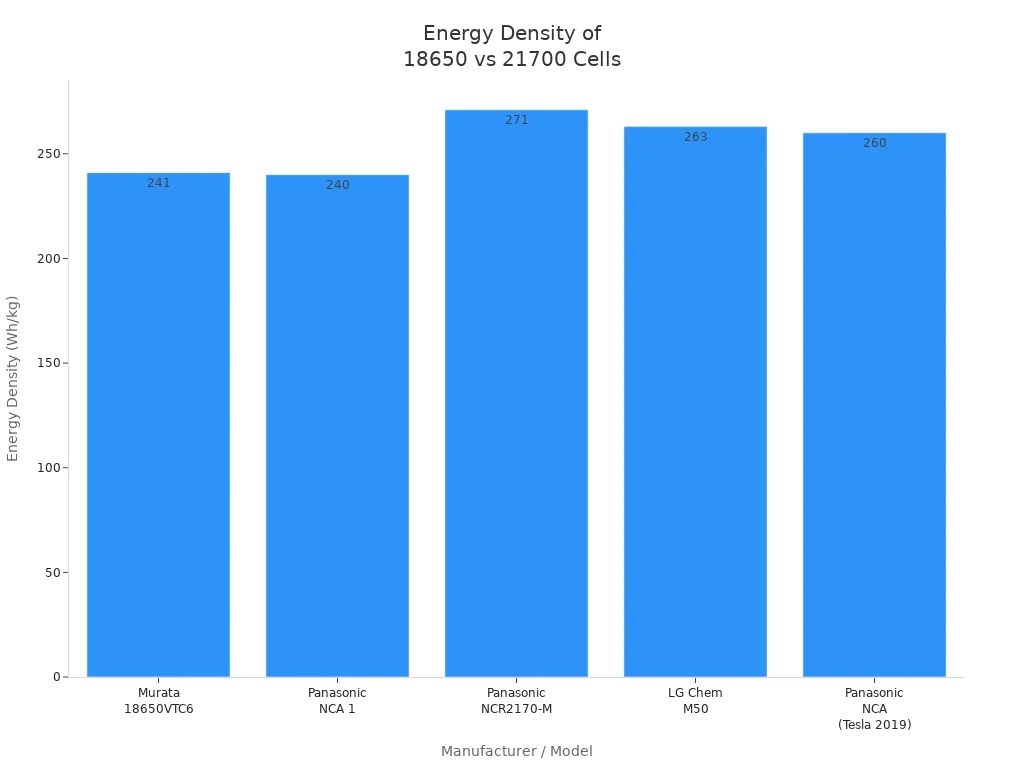
Manufacturers like Panasonic and LG Chem have developed 21700 batteries with energy densities above 260 Wh/kg. This higher capacity allows devices such as flashlights and power banks to run longer and perform better. The difference in capacity between these two battery types becomes clear when comparing their use in high-demand applications. The 21700 battery supports higher power output and longer use, while the 18650 battery remains a good choice for lighter, more compact devices.
The 18650 battery is smaller and lighter, making it ideal for portable devices.
The 21700 battery, with its higher capacity, suits applications that require extended runtime and greater power.
The difference in capacity and energy density directly impacts the performance and efficiency of lithium-ion batteries in real-world use.
Lifespan
Lifespan is another important factor when comparing lithium-ion batteries. The cycle life of a battery refers to how many times it can be charged and discharged before its capacity drops below a usable level. The key differences between 18650 and 21700 batteries include not only their size and capacity but also their durability.
18650 batteries usually last between 300 and 1000 charge cycles, depending on usage and battery chemistry. In contrast, 21700 batteries often last longer under similar conditions. The higher capacity and improved design of the 21700 battery contribute to its extended lifespan. This means users can expect better long-term performance and reliability from 21700 batteries, especially in devices that see frequent use.
The difference in capacity and cycle life makes 21700 batteries a strong choice for those who need both higher capacity and longer-lasting performance. However, both battery types benefit from proper care, such as avoiding extreme temperatures and using compatible chargers, to maximize their lifespan.
18650 and 21700 Cells: Ideal for Flashlights
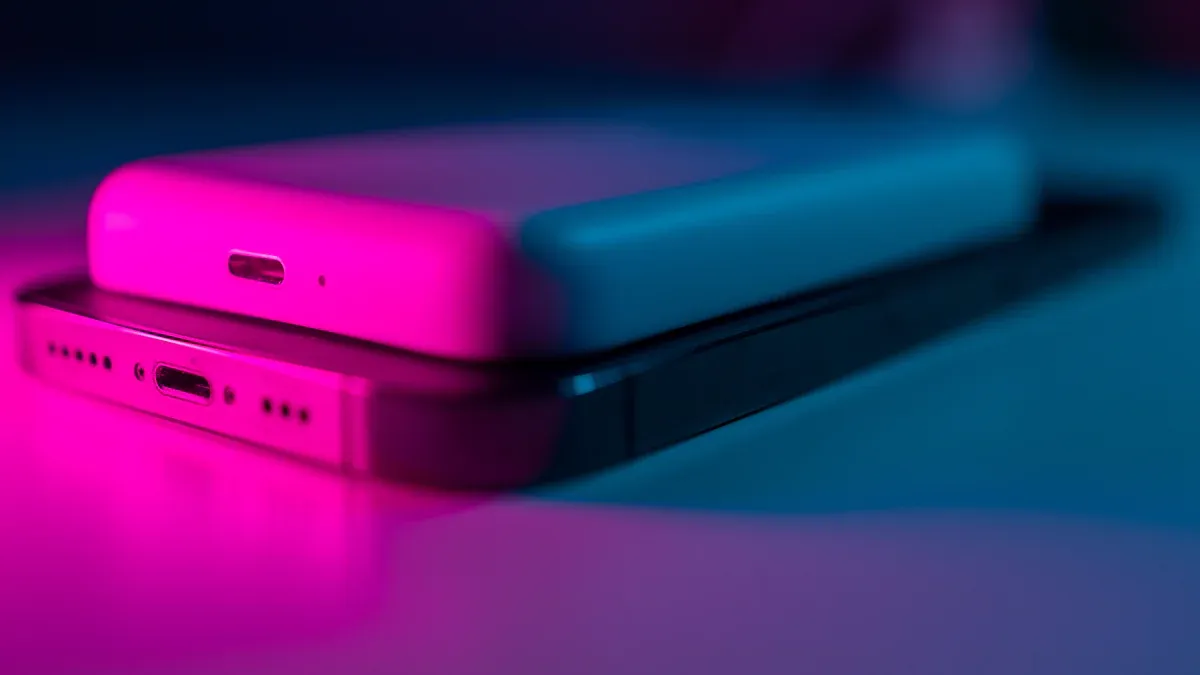
Size and Fit
The size and fit of a battery play a crucial role in determining whether it works well in a flashlight. 18650 and 21700 cells: ideal for flashlights, differ mainly in their dimensions. The 18650 battery measures 18mm in diameter and 65mm in length. This size fits most tactical and high-performance flashlights, making it a standard choice for many users. The 21700 battery, on the other hand, is larger at 21mm in diameter and 70mm in length. This extra size allows for higher capacity, which means longer runtime and brighter output in flashlights and LED lighting.
Manufacturers design many modern flashlights and LED lighting products to take advantage of the 21700 battery’s increased capacity. These flashlights often provide improved performance and longer use between charges. However, the larger size of the 21700 battery means it will not fit in older flashlight models built for 18650 cells. Users must always check the battery compartment size before choosing a battery. Using the wrong size can lead to poor fit, reduced performance, or even safety risks.
Tip: Always match the battery size to the flashlight’s specifications. A proper fit ensures safe operation and optimal performance.
Compatibility
Compatibility remains one of the most important factors when selecting between 18650 and 21700 cells: ideal for flashlights. Flashlights and LED lighting devices are designed with specific battery sizes in mind. The 18650 battery fits a wide range of flashlights, especially those that have been on the market for several years. Its established size and energy density make it a reliable choice for many users.
The 21700 battery, with its larger size, fits only in flashlights and LED lighting products designed for it. Attempting to use a 21700 battery in a device made for 18650 cells can cause several problems:
The battery may not fit into the compartment at all.
Forcing the battery can damage the electrical contacts or the battery holder.
Loose connections may lead to power interruptions or device failure.
Cramped compartments can cause short circuits or overheating.
Manufacturers often label their products clearly to indicate which battery type is compatible. Some users try to use adapter sleeves or external battery packs to fit different batteries, but these solutions can add bulk and complexity. Direct interchangeability between 18650 and 21700 cells: ideal for flashlights, is not recommended without proper device modifications.
Popular flashlight models show how battery choice affects performance:
Many tactical and high-powered flashlights use 18650 batteries for their balance of size and output.
Newer, high-end flashlights and LED lighting products use 21700 batteries to achieve longer runtimes and higher brightness.
Choosing the right battery ensures the flashlight operates safely and efficiently. Users should always verify compatibility before making a purchase.
Capacity and Runtime
Runtime in Flashlights
Battery capacity plays a major role in determining how long a flashlight can operate before needing a recharge. The 18650 battery usually offers a capacity between 2600mAh and 3600mAh. In contrast, the 21700 battery provides a higher capacity, often ranging from 4000mAh to 5000mAh. This increase in capacity allows for longer runtimes, which is especially important for applications requiring longer runtimes, such as outdoor adventures or emergency use.
A comparison of typical runtimes in flashlights shows a clear advantage for the 21700 battery. Under similar conditions, a flashlight powered by an 18650 battery will run for about 2 to 4 hours. When using a 21700 battery, the runtime extends to approximately 4 to 8 hours. This means users can expect double the runtime per cell with the 21700 format, making it ideal for those who need long battery life and fewer interruptions.
Battery Type | Typical Runtime in Flashlights (hours) | Capacity Range (mAh) |
|---|---|---|
18650 | 2 to 4 | 2600 to 3600 |
21700 | 4 to 8 | 4000 to 5000 |
Runtime in Power Banks
Power banks rely on battery capacity to determine how many times they can charge devices. The 21700 battery, with its higher capacity and improved energy density, allows power banks to store more energy. This results in a greater number of device charges compared to models using 18650 batteries. Most 18650 batteries offer around 3000mAh, while 21700 batteries can reach up to 5000mAh. This difference means power banks with 21700 cells deliver longer runtimes and more charges per cycle.
Users who need longer runtimes for their devices will benefit from choosing a power bank with 21700 batteries. These batteries support applications that demand extended use, such as travel or remote work. The higher capacity and longer runtimes make 21700 batteries a strong choice for anyone seeking reliable portable power.
Power and Light Output
Discharge Rate
The discharge rate of a battery determines how much current it can safely deliver to a device. This factor directly affects the performance of high-drain devices such as powerful flashlights. The difference in power and capacity between 18650 and 21700 batteries becomes clear when comparing their maximum continuous discharge rates.
Battery Model | Battery Type | Max Continuous Discharge (A) | Capacity (mAh) | Notes on Performance Impact |
|---|---|---|---|---|
Panasonic NCR18650B | 18650 | 4.8 | 3400 | Low discharge rate, suited for <2000 lumens flashlights |
Sony Murata VTC6 | 18650 | 30 | 3000 | High discharge, good balance for high output flashlights |
Molicell P28B | 18650 | 40 | 2800 | Very high discharge, suitable for brightest 18650 flashlights |
21700 | 35 | 4000 | High discharge and capacity, better thermal management | |
Samsung INR21700 30T | 21700 | 35 | 3000 | High peak discharge (61A), excellent for high power output |
Molicell INR21700 P42A | 21700 | 45 | 4200 | Superior discharge rate, supports higher lumens and runtime |
Molicell INR21700 P45B | 21700 | 45 | 4500 | High discharge and capacity, ideal for demanding flashlights |
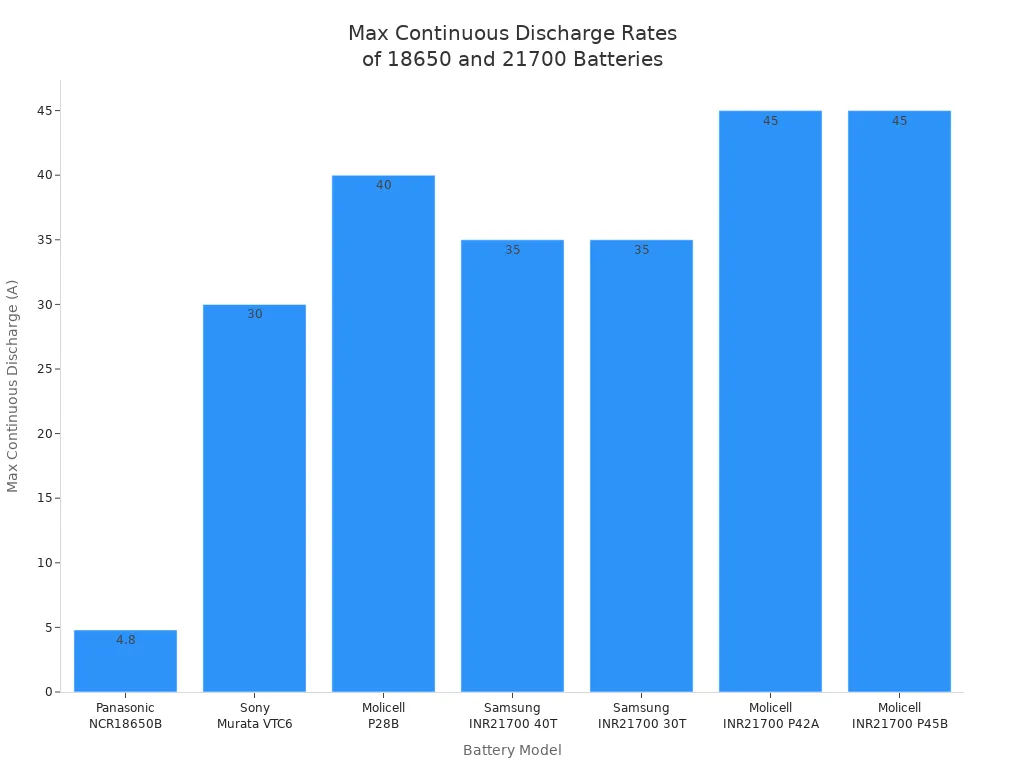
21700 batteries usually have lower internal resistance than 18650 batteries. This feature allows them to maintain stable voltage during high-drain applications. In real-world tests, 21700 cells run cooler and provide better thermal safety. High-drain devices benefit from this improved performance, as the battery can deliver more current without overheating. The larger surface area of 21700 batteries also helps dissipate heat, which protects both the battery and the device.
Brightness
Battery type plays a major role in the maximum brightness a flashlight can achieve. The 21700 battery, with its larger size and higher capacity, supports longer runtime and sustained light output. Many high-drain devices require a battery that can deliver high current for extended periods. The 21700 battery meets this need by offering a superior discharge rate and lower internal resistance.
The 21700 battery enables flashlights to produce brighter beams for longer periods.
High-performance flashlights designed for 21700 batteries can handle significant power demands.
The 18650 battery, while compact, may struggle to maintain maximum light output in high-drain devices.
Newer flashlight models often use 21700 batteries to take advantage of their improved performance.
The 18650 battery can have a shorter lifespan when used in high-drain applications.
Users who want the brightest light and longest performance should consider devices that support 21700 batteries. The difference in light output becomes especially noticeable in high-drain devices, where the battery must deliver consistent power.
Cost and Value
18650 Battery: Price and Availability
The 18650 battery remains one of the most widely available lithium-ion cells on the market. Many electronics stores and online retailers stock this battery, making it easy for users to find replacements or spares. The 18650 battery usually costs less per cell compared to newer formats. This lower price appeals to users who want to keep costs down, especially when buying multiple batteries for flashlights or power banks.
Most 18650 battery models offer capacities between 2200mAh and 3600mAh. The price per cell often ranges from $4 to $10, depending on the brand and quality. Users can find bulk packs at even lower prices per unit. The popularity of the 18650 battery ensures a steady supply and a wide range of choices. Many older flashlights and power banks use this battery, so users benefit from easy compatibility and affordable replacements.
Note: The 18650 battery offers a good balance of price, availability, and performance for many everyday devices.
21700 Battery: Price and Value
The 21700 battery has a higher individual cell price than the 18650 battery, but it delivers more value at the system level. Each 21700 battery typically costs between $7 and $15, reflecting its larger size and higher capacity. Most 21700 battery models provide capacities from 3000mAh to 4800mAh. This higher capacity means fewer cells are needed to achieve the same total energy in a device.
A comparison of battery system costs shows that the 21700 battery system costs about $170 per kWh, while the 18650 battery system costs around $185 per kWh. This results in an 8-9% cost savings for the 21700 battery system. The higher energy density and improved pack design of the 21700 battery contribute to this advantage. Fewer connecting wires and better thermal management also help reduce overall costs.
Battery Model | Capacity per Cell (mAh) | Energy Density (Wh/kg) | Cost of Battery System ($/kWh) |
|---|---|---|---|
18650 | 2200 – 3600 | 250 | 185 |
21700 | 3000 – 4800 | 300 | 170 |
The 21700 battery also offers a longer cycle life, which means users get more use out of each cell over time. This makes the 21700 battery a strong choice for those who want better long-term value, even if the upfront cost is higher.
Pros and Cons
18650 Battery
The 18650 battery remains a popular choice for many flashlights and power banks. Users often select this battery for its balance of size, performance, and availability. The advantages of the 18650 batteries include stable voltage output, which helps devices like flashlights maintain consistent brightness. Low internal resistance allows efficient energy transfer and reduces heat. High energy density means these batteries deliver substantial power in a compact form, making them ideal for portable power banks. Rechargeability with minimal memory effect supports frequent charging without losing capacity. Many users appreciate the durability, as these batteries can last through hundreds of charge cycles.
Note: High-drain 18650 batteries provide rapid power output, which suits high-performance flashlights and power tools. Protected models add safety by preventing overcharge, over-discharge, and short circuits.
However, some disadvantages exist. Safety concerns can arise if users mishandle or overcharge the battery. Performance may degrade after many charge-discharge cycles, leading to reduced capacity and voltage. Charging requires precise control, and improper chargers can damage the battery or shorten its lifespan. Unprotected 18650 batteries pose risks such as thermal runaway. High-drain models may have reduced capacity and shorter lifespan due to intense use, while protected batteries can be larger and more expensive.
21700 Battery
The 21700 battery has become the preferred option for many new flashlights and power banks. The advantages of using 21700 batteries start with their higher capacity, which means longer runtime for devices. These batteries offer improved energy density, allowing users to enjoy more power without a significant increase in weight. The 21700 battery also supports higher discharge rates, which helps high-performance flashlights achieve brighter output and longer operation. Another key benefit is the longer cycle life, which provides better long-term value for frequent users.
The advantages of using 21700 batteries extend to better thermal management and improved safety features in many modern designs. Fewer cells are needed to reach the same total energy, which simplifies battery pack construction and reduces overall system cost. Many users find that 21700 batteries deliver a strong combination of power, efficiency, and reliability.
Despite these strengths, the larger size of 21700 batteries may limit compatibility with older devices. Users must ensure their flashlight or power bank supports this format before making a purchase.
Real-World Use
Examples
Many popular flashlights and power banks rely on either 18650 or 21700 batteries. The 18650 battery powers well-known models from brands like NITECORE. These batteries offer a balance of size, capacity, and output, making them a favorite for both flashlights and portable chargers. Originally designed for laptops, 18650 cells now provide longer runtimes and higher power output than AA or AAA batteries. This makes them ideal for modern LED flashlights and power banks.
Use Case | Popular 18650 Battery Model | Key Performance Characteristics |
|---|---|---|
Flashlights | Panasonic NCR18650B | Capacity: 3400mAh, Continuous Discharge: 4.9A |
Power Banks | LG MJ1 | Capacity: 3500mAh, Continuous Discharge: 10A |
High-Drain Use | Sony VTC5A | Capacity: 2600mAh, Continuous Discharge: 25A |
High-Drain Use | Molicel P28A | Capacity: 2800mAh, Continuous Discharge: 25A |
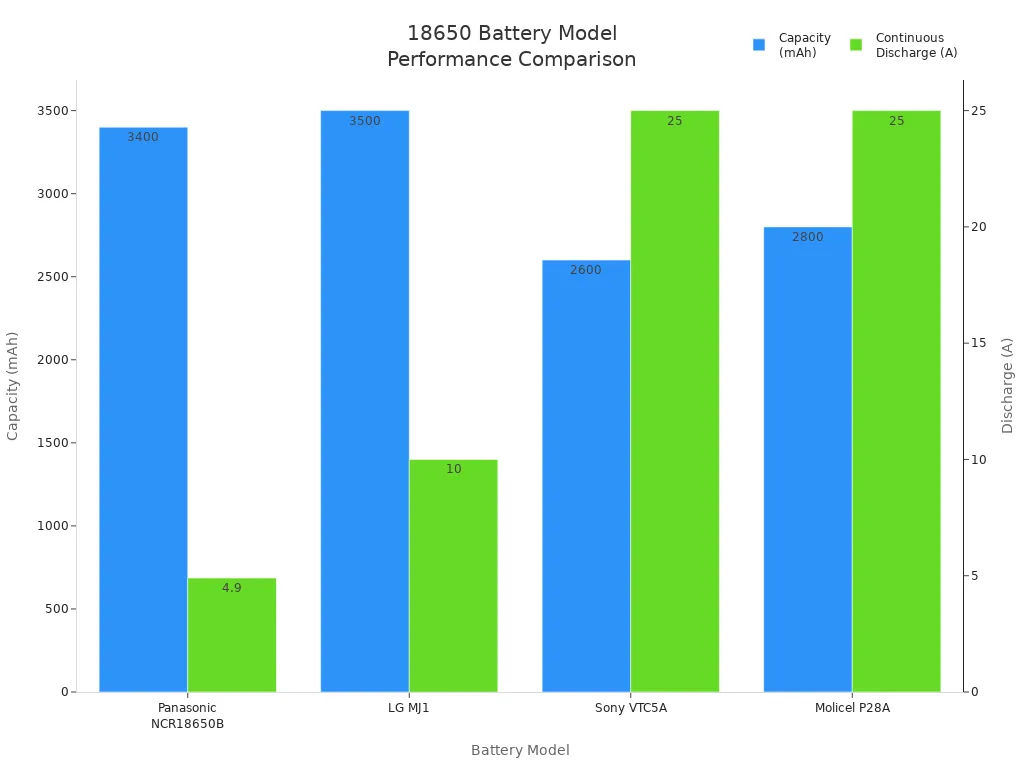
Flashlights and power banks also use 21700 batteries for higher capacity and energy density. Models like the Orbtronic 21700 (6000mAh) and Samsung 50E (5000mAh) support high-power devices. Fenix flashlights such as the HT18R and PD36R V2.0 list 21700 batteries as compatible. Power banks with 21700 cells deliver more charges and longer runtimes.
Model / Brand | Battery Type | Capacity (mAh) | Max Continuous Discharge (A) | Compatible Flashlight Models (Examples) |
|---|---|---|---|---|
Orbtronic 21700 | Protected Button Top Li-ion | 6000 | 13 | Fenix HT18R, HT32, LD45R, LR36R, PD36R V2.0, PD40R V3.0, PD45R ACE, TK22R, TK30R, CL27R |
Samsung 50E 21700 | Li-ion | 5000 | 9.8 | General high-power devices including flashlights and power banks |
Molicel P42A 21700 | Li-ion | 4200 | 45 | High-drain applications such as power tools, flashlights |
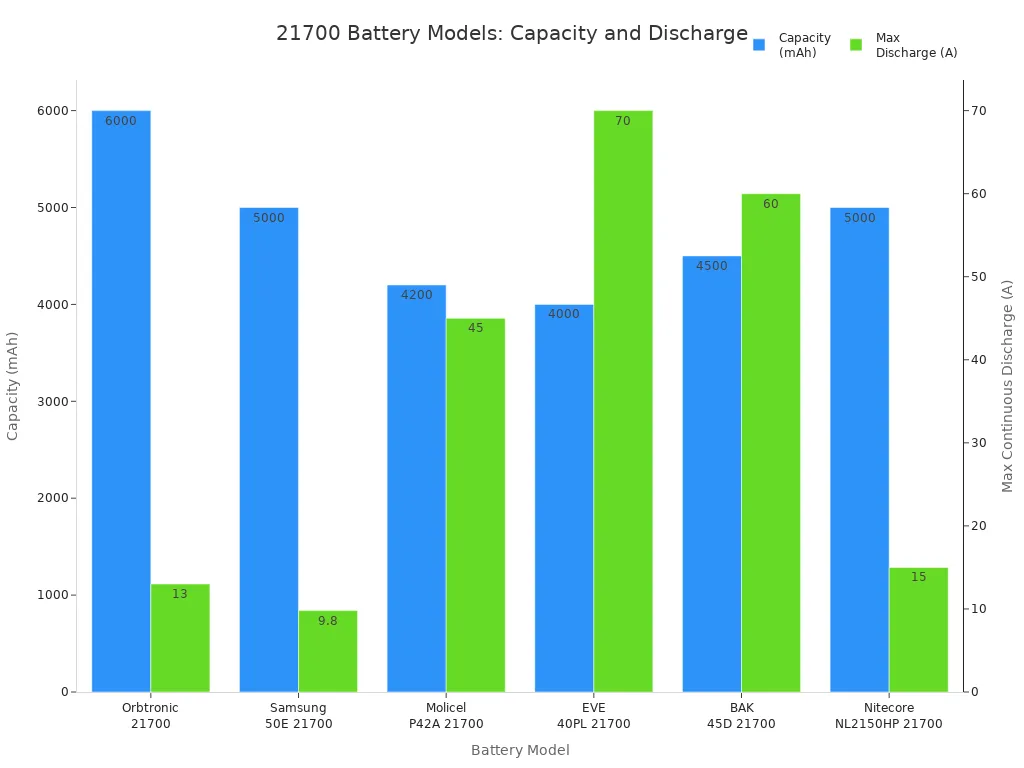
User Feedback
Users report that both 18650 and 21700 batteries deliver strong performance in real-world use. Test results show that 18650-powered flashlights often meet or exceed manufacturer claims for brightness and beam distance. Many users appreciate the rechargeability and long life of these batteries. They also note that rechargeable batteries like 18650 and 21700 outperform disposable AA or AAA batteries in flashlights and power banks.
Tip: Always buy batteries from trusted sources to avoid counterfeits. Users recommend checking reviews on reputable sites before purchasing.
Experienced users share several practical tips:
Use chargers designed for the specific battery type.
Avoid over-discharging; recharge before the battery is empty.
Monitor batteries during charging for overheating.
Store batteries at 40-60% charge if not used for a long time.
Inspect batteries regularly for swelling or leaks.
These habits help ensure safety and extend battery life. Many users also prefer smart chargers with displays to track charging progress. By following these tips, users get the best performance from their flashlights and power banks.
For most users, the 21700 battery stands out for longer runtime and higher power, making it ideal for high-performance flashlights and power banks. The 18650 battery remains a top pick for those who value compactness and budget. Users should always check device compatibility and follow safety guidelines, as both battery types require proper handling and quality chargers.
User Priority | Best Battery Choice |
|---|---|
Compactness, Budget | 18650 |
Runtime, Power | 21700 |
Tip: Choose reputable brands, inspect batteries regularly, and avoid extreme temperatures to ensure safe and reliable performance.
What is the main difference between 18650 and 21700 batteries?
The main difference is size and capacity. The 21700 battery is larger and stores more energy. This means longer runtime and higher power output. The 18650 battery fits smaller devices and remains widely available.
Can you use a 21700 battery in a device made for 18650?
No, a 21700 battery will not fit in most devices designed for 18650 cells. Always check the device’s specifications before choosing a battery. Using the wrong size can damage the device or cause safety issues.
Which battery lasts longer in a flashlight?
A 21700 battery usually lasts longer because it has a higher capacity. Users can expect more hours of light from a flashlight that supports 21700 cells. This makes it ideal for outdoor or emergency use.
Are 18650 batteries still a good choice for power banks?
Yes, 18650 batteries remain a good choice for many power banks. They offer reliable performance and are easy to find. Many compact power banks use 18650 cells because of their size and cost.
How can users ensure battery safety?
Tip: Always use batteries from trusted brands. Charge with the correct charger. Store batteries in a cool, dry place. Inspect for damage before use. Never mix old and new batteries in the same device.
See Also
Benefits Of Using Coilcraft XPL2010 In VRM Systems
Comparing STM32F401VCT6 And STR750FV2T6 For Medical Innovation
Ways MAX8647ETE+T Improves Smartphone Display Performance
CALL US DIRECTLY
(+86)755-82724686
RM2508,BlockA,JiaheHuaqiangBuilding,ShenNanMiddleRd,Futian District,Shenzhen,518031,CN
www.keepboomingtech.com sales@keepboomingtech.com
